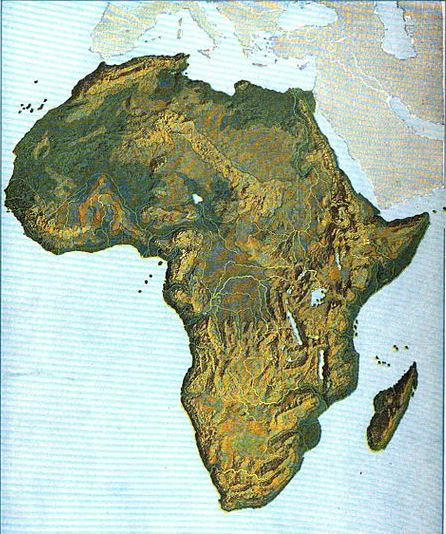Africa is the second-largest continent on Earth, both in terms of area and population, covering about 30.37 million square kilometers (11.7 million square miles) and home to over 1.3 billion people. It is a continent of incredible geographic diversity, ranging from vast deserts and tropical rainforests to expansive savannas, mountain ranges, and river systems. Africa’s geography plays a crucial role in shaping its climate, ecosystems, cultures, and economies.
This article explores the geographic features of Africa, including its major regions, mountains, rivers, deserts, and climate zones.
Major Geographic Regions of Africa
Africa can be divided into several geographic regions based on natural features, including North Africa, West Africa, East Africa, Central Africa, and Southern Africa. Each region has distinct physical characteristics, climates, and ecosystems.
1. North Africa
- Sahara Desert: North Africa is dominated by the Sahara, the largest hot desert in the world, stretching across countries like Morocco, Algeria, Tunisia, Libya, and Egypt. The Sahara covers much of North Africa and is known for its harsh, arid environment, extreme temperatures, and vast sand dunes.
- Atlas Mountains: The Atlas Mountains stretch across Morocco, Algeria, and Tunisia, creating a rugged terrain with peaks that rise above 4,000 meters (13,000 feet). These mountains act as a barrier between the coastal Mediterranean climate and the inland deserts.
- Nile River: The Nile, the longest river in the world, flows northward through Egypt and into the Mediterranean Sea. Its fertile banks are vital for agriculture and civilization in the otherwise arid region.
2. West Africa
- Sahel: The Sahel is a semi-arid region just south of the Sahara, stretching from Senegal to Sudan. It is a transitional zone between the desert to the north and the more fertile savannas and forests to the south. The Sahel is prone to droughts and desertification.
- Savannas: Much of West Africa consists of savannas, vast grasslands dotted with trees, stretching across countries like Nigeria, Ghana, and Mali. These regions support diverse wildlife and agriculture.
- Coastal Rainforests: The coastal areas of Sierra Leone, Liberia, and Côte d’Ivoire are characterized by tropical rainforests, rich in biodiversity, with humid and wet climates.
3. East Africa
- Great Rift Valley: One of East Africa’s most prominent geographic features is the Great Rift Valley, a massive trench that runs from Ethiopia to Mozambique. This geological fault line is home to numerous lakes, mountains, and volcanoes, including Mount Kilimanjaro, the highest peak in Africa.
- Savannas and Grasslands: The East African savannas, such as the Serengeti in Tanzania and Kenya, are famous for their vast grasslands and wildlife, including elephants, lions, and giraffes.
- Indian Ocean Coast: East Africa’s coast, along the Indian Ocean, features fertile lands and port cities like Mombasa and Dar es Salaam, which have historically been centers of trade and culture.
4. Central Africa
- Congo Basin: Central Africa is dominated by the Congo Basin, the second-largest rainforest in the world after the Amazon. This region, which includes countries like Democratic Republic of the Congo and Republic of the Congo, is home to dense rainforests, rich biodiversity, and the Congo River, the second-longest river in Africa.
- Rainforest Ecosystem: The equatorial rainforests are known for their hot, humid climate and incredible biodiversity, including gorillas, chimpanzees, and numerous species of birds and insects.
5. Southern Africa
- Kalahari Desert: Southern Africa includes the Kalahari Desert, a large semi-arid sandy savanna that stretches across Botswana, Namibia, and South Africa. Though it is called a desert, it supports a variety of wildlife and vegetation.
- Drakensberg Mountains: The Drakensberg Mountains in South Africa and Lesotho feature rugged, high-altitude terrain, with peaks rising above 3,000 meters (9,800 feet).
- Cape of Good Hope: The southernmost point of Africa is marked by the Cape of Good Hope, near Cape Town, South Africa, where the Atlantic and Indian Oceans meet.
Major Rivers and Lakes of Africa
Africa is home to several major rivers and lakes that have played an essential role in the development of civilizations, agriculture, and ecosystems.
1. Nile River
- The Nile River is the longest river in the world, stretching approximately 6,650 kilometers (4,130 miles) from Lake Victoria in East Africa to the Mediterranean Sea. It flows through Uganda, Sudan, and Egypt, supporting millions of people with fertile land for agriculture, particularly in Egypt.
2. Congo River
- The Congo River is the second-longest river in Africa and has the largest discharge of any river on the continent. It flows through Central Africa, winding through the Congo rainforest and providing essential resources for communities and wildlife.
3. Niger River
- The Niger River runs through West Africa, flowing through countries like Guinea, Mali, Niger, and Nigeria. It is a vital water source for agriculture and fishing, particularly in the fertile Niger Delta.
4. Zambezi River
- The Zambezi River in Southern Africa is known for its spectacular waterfalls, including Victoria Falls, one of the largest and most famous waterfalls in the world. The Zambezi River is also a source of hydroelectric power.
5. Lake Victoria
- Lake Victoria is the largest lake in Africa and the second-largest freshwater lake in the world by surface area. It lies between Tanzania, Uganda, and Kenya and is the source of the Nile River.
6. Lake Tanganyika
- Lake Tanganyika is the second-deepest freshwater lake in the world, located between Tanzania, Democratic Republic of the Congo, Burundi, and Zambia. It is known for its biodiversity, particularly its unique fish species.
Deserts of Africa
Africa is known for its vast deserts, which cover a significant portion of the continent, particularly in the north.
1. Sahara Desert
- The Sahara is the world’s largest hot desert, covering much of North Africa. It stretches across 11 countries and is known for its extreme temperatures, vast sand dunes, rocky plateaus, and occasional oases.
2. Kalahari Desert
- The Kalahari Desert in Southern Africa is a semi-arid sandy savanna rather than a true desert. It supports a range of wildlife and is home to indigenous peoples like the San Bushmen.
3. Namib Desert
- The Namib Desert, located along the southwestern coast of Africa in Namibia, is one of the oldest deserts in the world. Its unique red sand dunes and proximity to the Atlantic Ocean create a striking landscape.
Climate Zones of Africa
Africa’s climate is diverse, ranging from tropical to arid to temperate.
1. Equatorial Climate
- The equatorial regions of Central Africa, including the Congo Basin, have a hot, humid, and rainy climate year-round. This region supports lush tropical rainforests and high biodiversity.
2. Tropical Savanna Climate
- Much of sub-Saharan Africa, including East Africa and West Africa, experiences a tropical savanna climate, with distinct wet and dry seasons. These regions are home to grasslands, woodlands, and iconic wildlife like lions, elephants, and giraffes.
3. Arid and Semi-Arid Climate
- The Sahara and Sahel regions of North Africa and parts of Southern Africa experience arid and semi-arid climates. These regions are characterized by low rainfall, hot temperatures, and sparse vegetation.
4. Mediterranean Climate
- Northern Africa’s Mediterranean coast, including parts of Morocco, Tunisia, and Algeria, has a Mediterranean climate with hot, dry summers and mild, wet winters, supporting agriculture like olives and citrus fruits.
5. Highland Climate
- The highlands of East Africa, such as the Ethiopian Highlands and Mount Kilimanjaro, have cooler temperatures due to their elevation. These areas support unique ecosystems and agriculture.
Africa’s geography is as diverse as its cultures, offering a rich tapestry of landscapes that range from vast deserts and towering mountain ranges to dense rainforests and sprawling savannas. The continent’s rivers and lakes provide lifelines for both human populations and wildlife, while its varied climate zones support an incredible range of ecosystems. Understanding Africa’s geography is essential for appreciating the environmental, economic, and cultural dynamics of this vast and complex continent.



